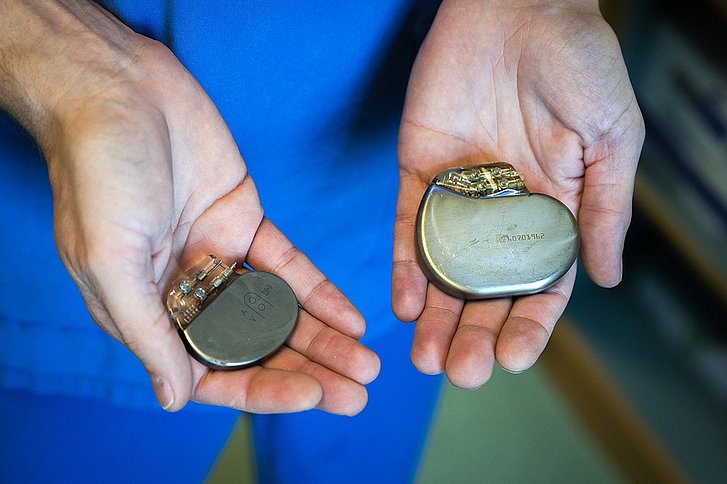If your heartbeat is too slow - less than 60 beats per minute - or if it stops for an extended period, then this is known as bradycardia. This condition requires urgent treatment, because it can result in frequent loss of consciousness and, in the most serious cases, cardiac arrest.
Pacemaker implantation

Ist Ihr Herzschlag zu langsam, zeigt deutliche Aussetzer oder steigt bei Anstrengungen nicht genug an, kann der Einsatz eines Herzschrittmachers vonnöten sein.
When am I likely to need a pacemaker?
A pacemaker can be fitted to prevent these symptoms from occurring. It stimulates the heart muscle to beat by administering a gentle electric pulse at regular intervals. The pacemakers implanted at our clinic are also used to treat a slowed heartbeat caused by a disorder of the sinus or atrioventricular (AV) nodes.
Heart surgery or rhythmological intervention?
![[Translate to Englisch:] Monitor bei rhythmologischem Eingriff](/fileadmin/_processed_/0/5/csm_Rhythmologie_EPU_9107_27980f070d.jpg)
Our specialists will decide on a case-by-case basis whether you require heart surgery or the implantation of a pacemaker, or whether rhythmological intervention is indicated.
The implantation of a pacemaker is not necessarily required in all cases of cardiac arrhythmia. The first step will be to take a detailed case history: in other words, we will find out as much as possible about the progression of your condition and will conduct diagnostic examinations, such as an ECG, Holter monitoring, and an echocardiogram (cardiac ECG). These diagnostic tools help us to determine what precisely is the most suitable treatment for you and your heart.
It a decision is made to implant a pacemaker, a date will be scheduled for the intervention.
- Only a local anesthetic (rather than general anesthetic) is usually required.
- First, electrodes are passed through a vein in your clavicle to your heart, and secured there. They will later be connected to the pacemaker.
- The pacemaker is implanted under the skin in the fatty tissue below one of the clavicles and 'connected up' using the electrodes.
- Usually, the entire intervention will last for no longer than an hour, and you will be able to leave your bed just a few hours later.
Aftercare and service life of the pacemaker
Risks involving the pacemaker itself - technical defects, that is - are very rare. A modern pacemaker has a service life of between five and ten years, depending on how often it is used. The battery of the pacemaker will have drained by then, and will have to be replaced.
Regular monitoring
The functioning of the pacemaker, battery and electrodes should be monitored regularly to avoid complications. The initial check will usually be made after a month and the second after three months, followed by six-monthly check-ups.